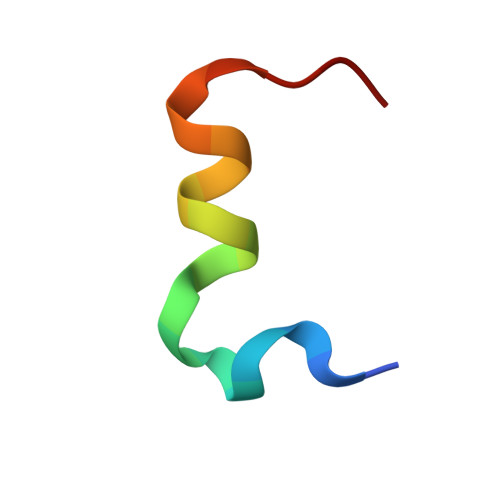3D structure determination of STARP peptides implicated in P. falciparum invasion of hepatic cells.
Bermudez, A., Alba, M.P., Vanegas, M., Patarroyo, M.E.(2010) Vaccine 28: 4989-4996
- PubMed: 20580741
- DOI: https://doi.org/10.1016/j.vaccine.2010.05.025
- Primary Citation of Related Structures:
2MTY, 2MU6 - PubMed Abstract:
To block the different stages of Plasmodium falciparum invasion into human hepatocytes and red blood cells, we have focused on those proteins belonging to the pre-erythrocytic stage. One of these proteins is Sporozoite Threonine and Asparagine Rich Protein (STARP), which is a ligand used by P. falciparum parasites to bind Hepatic cells (HepG2). Previous studies on this protein identified two conserved peptides binding with high activity to HepG2 cells (namely 20546 and 20570) with corresponding critical hepatic-cell binding residues and determined an important role for these two peptides in the invasion process. This study shows the results of immunization trials in Aotus monkeys with native STARP peptides and analogues modified in critical hepatic-cell binding residues. The results show that native peptides are not immunogenic but can induce high-antibody titers when their critical residues are replaced by other with similar volume and mass but different polarity. Nuclear Magnetic Resonance ((1)H NMR) studies revealed that native peptides (non-immunogenic) displayed shorter alpha-helical regions compared to their highly immunogenic modified analogues. Binding assays with HLA-DRbeta1* molecules showed that 20546 modified peptides inducing high-antibody titers (24972, 24320 and 24486) bound to HLA-DRbeta1*0301 molecules, while the 20570 modified analogue (24322) bound to HLA-DRbeta1*0101. The results support including these high-immunogenic STARP-derived modified peptides as pre-erythrocytic candidates to be included in the design of a synthetic antimalarial vaccine.
Organizational Affiliation:
Fundación Instituto de Inmunología de Colombia (FIDIC), Colombia.


















